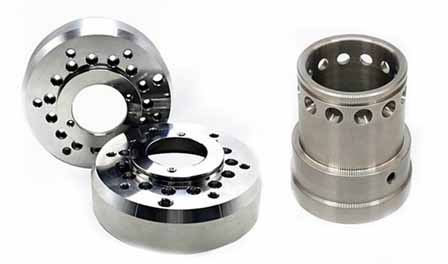TC4의 고속 밀링시, Gc.2, 순수 티타늄 일체형 구조, 일반적으로 하향 밀링이 사용됩니다.. 공구는 티타늄 가공물을 천천히 절단하여 발생하는 열을 줄이고 반경 방향 힘을 줄입니다..
티타늄 합금 TC4를 밀링할 때 (Ti-6Al-4V), 비대칭 하향 밀링이 자주 사용됩니다., 커터 톱니의 앞쪽 끝이 먼저 작업물에 닿도록. When the milling cutter teeth are separated, the chips are very thin and are not easy to stick to the cutting edge. The opposite is true for up milling, which tends to stick chips. 커터 톱니가 다시 절단될 때, 칩이 고장났어요, 커터 재료가 벗겨지고 부서지는 원인이 됩니다.. 둘째, maintain a stable cutting load as much as possible, because changes in load will cause tool deflection, thereby reducing machining accuracy and surface quality, and shortening tool life. 마지막으로, when machining titanium parts with large removal margins (such as groove machining of large titanium parts), layered milling, small depth of cut, and medium feed are generally used. When machining the inner cavity of titanium, when the tool enters the corner, adopt trochoidal milling, which can avoid the sudden increase of cutting force, otherwise the heat generated will destroy the performance of the titanium material.
현재, in the high-speed machining of the aviation manufacturing industry, the milling speed of titanium alloy can reach more than 90m/min, and the cutting speed of aluminum alloy can reach 1500~6000m/min. When processing aluminum alloy in this speed range, the milling temperature is higher than the corresponding temperature at which the built-up edge disappears, which effectively avoids the generation of built-up edge and improves the quality of the processed surface. 동시에, the higher the silicon content of the aluminum alloy, the lower the milling speed should be. When processing high silicon aluminum alloy, the cutting speed is 300~1500m/min, the processing effect is better.
The commonly used cutting solutions are: high cutting speed, medium feed and small depth of cut. 하지만, in actual processing, it is not that the higher the cutting speed, the better the effect. It is necessary to comprehensively consider the workpiece, cutting tool and equipment to formulate a reasonable processing plan. 예를 들어, there are two boss holes in the cavity of an aircraft wing part (티타늄 합금) produced by an aerospace manufacturing company. 그림과 같이 1. Adopting cemented carbide end mills, cutting speed v=1300m/min, feed rate fz=0.5mm/z, cutting depth ap=3~5mm, reciprocating tool passes over the boss hole to process, the processing cost is too high. After process improvement, high-speed steel tools are used in the A area, the cutting speed v=800m/min, the large cutting depth ap=10mm, and the position of the boss hole after rough machining. Replacing cemented carbide tools for high-speed milling in area B not only ensures machining efficiency and surface accuracy, but also reduces costs.

티타늄 합금 구조 부품 밀링
 English
English العربية
العربية 中文(漢字)
中文(漢字) Čeština
Čeština Dansk
Dansk Nederlands
Nederlands Suomi
Suomi Français
Français Deutsch
Deutsch Italiano
Italiano 日本語
日本語 ಕನ್ನಡ
ಕನ್ನಡ 한국어
한국어 Português
Português Русский
Русский Slovenčina
Slovenčina Español
Español Svenska
Svenska Türkçe
Türkçe

